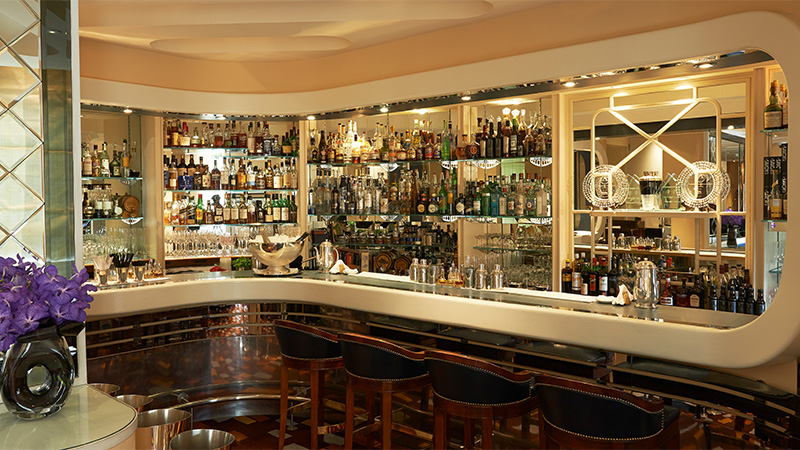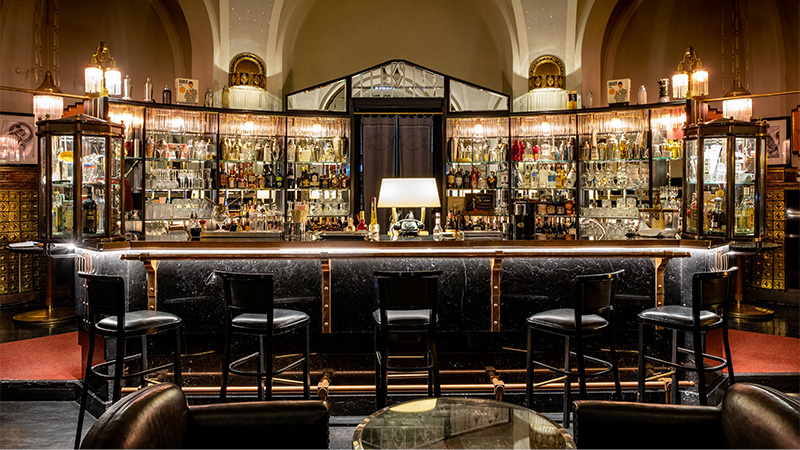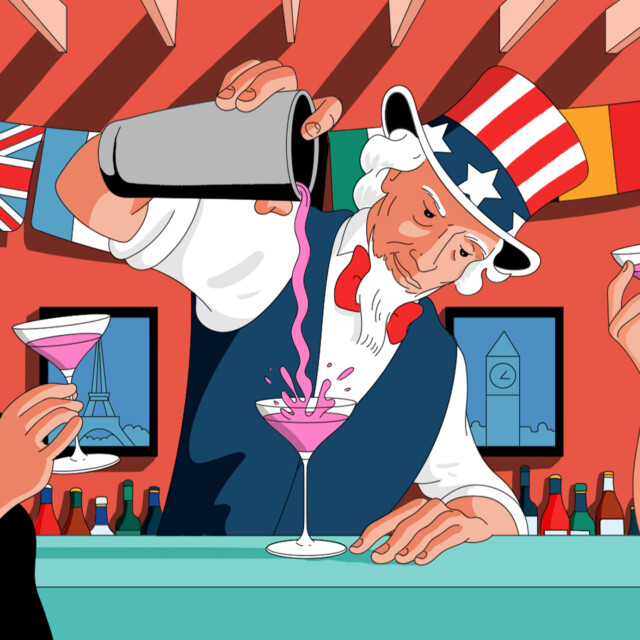Everyone in hospitality is familiar with the pressure of welcoming and serving guests. Then there are those who are working behind the stick at places like the American Bar in London, a significant drinking destination since it first opened inside the Savoy Hotel sometime in the 1890s. As the American Bar’s former head bartender Shannon Tebay points out, there are slightly different expectations when you’re working in a place that has served guests like Mark Twain, Marilyn Monroe, Charlie Chaplin, and Winston Churchill.
“It’s a lot of pressure,” she says, with a quiet laugh. “It’s a tremendous responsibility when you have the privilege of working in a place like that, one that people regard so highly. You have to be on all the time.”
That kind of pressure can be found far beyond the Savoy Hotel. Across Europe, modern cocktail culture is still influenced by a handful of historic, American-inspired bars, many of which are now well into their second centuries of operation. Often called “American” or “New York” bars to show that they served American-style cocktails, a novelty at the time, today they run the gamut in terms of quality, from what are arguably tourist traps to some of the most important drinking establishments anywhere (the American Bar inside the Savoy Hotel was rated the world’s best bar in 2017). While they might be influential, these storied watering holes present a number of unique challenges, from customers who might not really care about drinks to outdated bar setups.
Seeing Things in Person
What makes a place like the American Bar in London, Vienna’s vintage-1908 Loos American Bar, or Harry’s Bar in Venice, which dates from 1931, so appealing for customers?

“They have so much history and so many stories behind them,” Tebay says. “Just thinking about all the names that have come through there — people want to go and be a part of that history and a part of that story, and be able to say that they were there. People want to see what all the fuss is about.”
That seems to be true for both bartenders and customers. Tebay made headlines in newspapers like The Guardian and The New York Times when she joined the American Bar from Death & Co. in New York; several articles highlighted her status as the first American to run the place and also the first woman since Ada “Coley” Coleman in 1903. (Tebay has recently moved on to a new project, which will see her opening several bars in the area around London’s Denmark Street.) For both drinkers and drink slingers, the “time machine” aspect of stepping into one of the origin points of cocktail culture can be especially appealing. Or, to put it another way: It’s one thing to page through “The Savoy Cocktail Book,” the highly influential text on mixing drinks from 1930, but it’s another thing entirely to mix drinks at the bar where that book was written.
The charm is especially strong for fans of classic mixology. A trip to a place like Harry’s New York Bar in Paris, founded in 1911, can help you calibrate your senses on the recipes that were said to have been invented (or at least popularized) there, including the Bloody Mary, the Sidecar, the Old Pal, and the Monkey Gland.
That sense of past glory is common in Europe’s historic American-inspired bars — though it can sometimes go too far. Modern customers might want to visit Harry’s Bar in Venice because of its role as the place where the Bellini was invented, but they might also be put off by its mass-produced, branded glassware, which can seem unsophisticated to contemporary drinkers. As the Italian cocktail writer Maurizio Maestrelli points out, a good bar has to balance its respect for the past with the sensibilities of the present.
“Bars are not museums, or at least they should be ‘living’ museums,” he says. “It can be amazing to sit maybe where Hemingway used to sit and drink, or where George Clooney had a Negroni, but I prefer good service and a perfect drink — if possible, in a nice glass.”
For Tebay, historic bars like the Savoy’s hit their stride when they look forward as well as back, though she notes that it requires a lot of creativity and innovation for historic bars to stay relevant to modern tastes. “Which maybe is why sometimes those are the spots that end up really embracing new contemporary styles,” she says. “to try and not just rest on their laurels, their history, and the fact that they have been around so long.”
Workspaces From the Past
Adding a modern touch might be a nice goal, but in some cases it can be almost impossible to achieve. When bartender Michael Tretter took over the American Bar in Prague’s landmark Obecní Dům (or “municipal house”) building earlier this year, he was surprised by the limitations on what he could do in the space: Effectively, he was allowed to make no changes whatsoever. Dating from 1912 and loaded with ornate Art Nouveau touches that include wall inlays of real ivory, Prague’s American Bar is registered under the city’s strictest historical protection, due to its architectural and cultural significance. Its deep leather chairs, ornate vintage chandelier, and copper service bar are all completely original.
As Tretter notes, you can see how the space dates from a different era as soon as you start to make drinks.
“See these bottle shelves? Several of my bottles are taller than the shelves, but I’m not allowed to change the height of the shelves,” he says. He points to the copper-topped service bar. “Or here, if I’m making a drink, there’s no sink. There’s nowhere to wash anything. The workspace is really impractical.”

Impractical though it may be, Prague’s American Bar is gorgeous. A circular salon capped with a vintage fresco of a gray heron by the Czech artist Mikoláš Aleš, it has an atmosphere unlike anything else in a city that’s filled with great drinking spots. The question is how to make things work in a setting that was designed over 110 years ago. There’s an unusual amount of room to maneuver between the bar and the bottle shelves, which helps, but as Tretter points out, the bar itself wasn’t originally designed to hold a cash register, let alone a card reader.
Other historic bars have similar quirks, from counters and shelves that are much too low to a paucity of electrical outlets or places where employees can wash their hands. In terms of service, many historical bars were originally set up for simple pours of individual spirits, rather than mixing drinks.
Tebay suggests that bartenders consider adapting their offerings to the location, rather than the other way around.
“That can be very challenging, especially when you get into a style of drinks-making that is more contemporary, but you’re working behind a bar that perhaps has a slightly outdated build,” she says. “Instead of trying to retrofit your bar to what type of drinks you want to make, I think you should design great programs around that specific bar and that space in that room.”
Tretter has a few decades of experience organizing and scheduling work shifts at his original bar in Prague. But, he says, the American Bar in Obecní Dům required a new organizational approach — or, rather, an older one.
“The bar was built for simple drinks that don’t require much prep,” he says. “To make it work here, we created a system that is much more like how bartending teams were organized in the 1930s.” That means a head bartender who only mixes drinks and who doesn’t deal with orders, money, or payments; an assistant bartender who helps out with drinks and focuses on payments and taking orders; and a “commis” who works as a barback and dishwasher. With that structure, the American Bar in Obecní Dům can serve a full line of classic drinks that includes a circa-1884 Adonis cocktail and a Cynar Shakerato. Without it, he says, the bar couldn’t function.
Right Place, Right People
That speaks to an underappreciated point: While the focus is often on the historic buildings and their antique furnishings, even Europe’s most historic American-style bars are all about people, on both sides of the counter.
For Maestrelli, places like Milan’s Bar Basso, founded in 1947, offer an ideal mix of historic character and contemporary vibes, thanks in part to its crowd of neighborhood regulars.
“It’s quite a common pleasure to go to Bar Basso, even if you don’t feel you are going in a legendary place — good service, friendly atmosphere,” he says. “Personally, I consider these kinds of bars, where you can feel the history but it doesn’t obscure the daily routine of having a drink or two, the best choice you can make.”
For Tebay, venues like the American Bar offer rich opportunities for up-and-coming bartenders to be part of something big. In return, those employees offer the lifeblood that can help keep a historic place going.
“It’s fun to see people come in and try to put their own fingerprint on the history,” she says.
“That’s how those places stay important over the years: by discerningly hiring people who get it, who care and really want to do right by the establishment — and most importantly, by their guests.”
